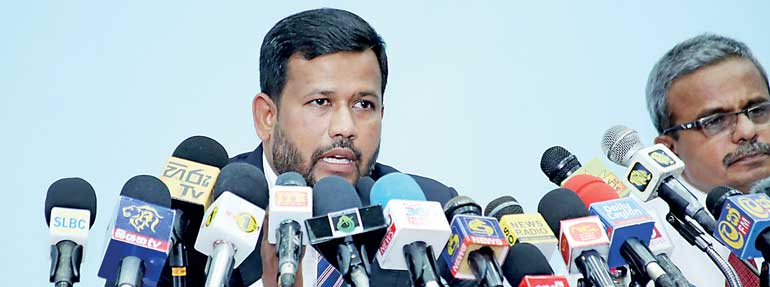Wednesday Jul 02, 2025
Wednesday Jul 02, 2025
Tuesday, 21 February 2017 00:05 - - {{hitsCtrl.values.hits}}
 Minister of Industry and Commerce Rishad Bathiudeen (left) addresses the special press briefing on rice held at the Government Information Department yesterday as Industry and Commerce Ministry Secretary Chinthana Lokuhetti (right) looks on
Minister of Industry and Commerce Rishad Bathiudeen (left) addresses the special press briefing on rice held at the Government Information Department yesterday as Industry and Commerce Ministry Secretary Chinthana Lokuhetti (right) looks on
Despite 400,000 MT of rice being discovered within Sri Lanka’s retail market at this very moment, an unscrupulous play within the system has resulted in a supply crisis, alleged Sri Lanka’s Minister of Industry and Commerce yesterday in Colombo.
Industry and Commerce Minister Rishad Bathiudeen also asked not to blame local rice millers for the crisis while hinting that Sri Lanka had not decided on a country from which to import buffer stocks, but “is ready to (place the order) for import” as well.
Minister Bathiudeen, joined by his top officials, was addressing a special press briefing on the country’s rice supply status held at the Government Information Department in Narahenpita last afternoon.
Explaining the present situation, Minister Bathiudeen said: “We need 200,000 MT of rice monthly. The Hector Kobbekaduwa Agrarian Research and Training Institute (HARTI) has informed us today (20 February) that after they conducted their own investigations, they discovered almost 400,000 MT of rice volumes available across Sri Lanka’s retail market system even at this very moment. In addition, 86,000 MT of rice has also been imported and arrived. We even reduced the rice import tax from Rs. 75 to Rs. 5. Therefore there is really no shortage and the crisis is over. Still, there are supply issues in the market. This is due to some form of planned manipulation of the rice market by certain interested parties. To overcome this, we introduced Maximum Retail Prices (MRPs) for both imported and locally milled rice,” said Minister Bathiudeen.
“Sellers and importers who do not release rice to the consumers or who sell at higher prices are liable. They must display price lists. Imported rice cannot be sold as local rice. In fact, two teams from the CAA are specially working on checking up on such switching. Already the Consumer Affairs Authority under my Ministry has conducted more than 3,000 raids since January 2017 and has filed cases on 1,200 identified violations from these raids.
“We have also cancelled all leave of CAA employees to continue with the raids. To resolve the situation, we have also been holding many meetings together with President Maithripala Sirisena, along with importers, millers and distributors, etc. The President alone had five such meetings recently. We also informed the importers to furnish all details of their imports, including purchase costs and arrival dates of rice at Sri Lankan ports. We should not be continuously blaming the local millers alone and should not make them solely responsible for this crisis. It is the opportunistic traders and certain others who are behind this crisis due to their exploiting nature. We are ready to import new buffer stocks if necessary. Our country’s rice buffer stock level is 100,000 MT. The Government is ready to import this amount but is yet to decide as to which country to import from. Some officials of the Department of Commerce under my Ministry who are posted abroad are now sending international wholesale rice prices on a daily basis to us.”
By Extraordinary Gazette 2006/52 dated 17 February, the CAA under Minister Bathiudeen gazetted MRPs of three varieties of rice, separately for both imported and locally milled rice. Accordingly, Samba (non-Keeri and non-Suduru) was priced per kilogramme at Rs. 80 for imported rice and Rs. 90 for locally milled rice, Raw (Kekulu) was priced per kilogramme at Rs. 70 for imported rice and Rs. 78 for locally milled rice and Nadu was priced per kilogramme at Rs. 72 for imported rice and Rs. 80 for locally milled rice.
Discover Kapruka, the leading online shopping platform in Sri Lanka, where you can conveniently send Gifts and Flowers to your loved ones for any event including Valentine ’s Day. Explore a wide range of popular Shopping Categories on Kapruka, including Toys, Groceries, Electronics, Birthday Cakes, Fruits, Chocolates, Flower Bouquets, Clothing, Watches, Lingerie, Gift Sets and Jewellery. Also if you’re interested in selling with Kapruka, Partner Central by Kapruka is the best solution to start with. Moreover, through Kapruka Global Shop, you can also enjoy the convenience of purchasing products from renowned platforms like Amazon and eBay and have them delivered to Sri Lanka.
Discover Kapruka, the leading online shopping platform in Sri Lanka, where you can conveniently send Gifts and Flowers to your loved ones for any event including Valentine ’s Day. Explore a wide range of popular Shopping Categories on Kapruka, including Toys, Groceries, Electronics, Birthday Cakes, Fruits, Chocolates, Flower Bouquets, Clothing, Watches, Lingerie, Gift Sets and Jewellery. Also if you’re interested in selling with Kapruka, Partner Central by Kapruka is the best solution to start with. Moreover, through Kapruka Global Shop, you can also enjoy the convenience of purchasing products from renowned platforms like Amazon and eBay and have them delivered to Sri Lanka.